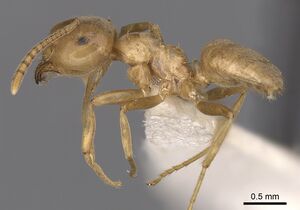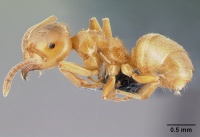Lasius reginae
| Lasius reginae | |
|---|---|

| |
| Conservation status | |
| Scientific classification | |
| Kingdom: | Animalia |
| Phylum: | Arthropoda |
| Class: | Insecta |
| Order: | Hymenoptera |
| Family: | Formicidae |
| Subfamily: | Formicinae |
| Tribe: | Lasiini |
| Genus: | Lasius |
| Section: | flavus clade |
| Species group: | carniolicus |
| Species: | L. reginae |
| Binomial name | |
| Lasius reginae Faber, 1967 | |
This rarely encountered species inhabits open dry forest edges and steppe habitats in eastern Mongolia (Aibek & Yamane, 2010). Nests are in soil with a mound around the entrance. They exhibits temporary social parasitism. Queens found new colonies by infiltrating an established nest of Lasius alienus, Lasius myops (unconfirmed) or Lasius psammophilus (de la Mora et al., 2021; Seifert, 2018), killing the queen and using host workers to care for her initial brood.
| At a Glance | • Temporary parasite |
Identification
Distribution
Recorded from several European countries, as well as from Turkey and Mongolia (Aibek and Yamane 2010, Borowiec 2014, Lapeva-Gjonova & Borowiec, 2022).
Latitudinal Distribution Pattern
Latitudinal Range: 47.655521° to 37°.
| North Temperate |
North Subtropical |
Tropical | South Subtropical |
South Temperate |
- Source: AntMaps
Distribution based on Regional Taxon Lists
Palaearctic Region: Austria (type locality), Bulgaria, Czech Republic, Germany, Mongolia, Slovenia, Türkiye.
Distribution based on AntMaps
Distribution based on AntWeb specimens
Check data from AntWeb
Countries Occupied
| Number of countries occupied by this species based on AntWiki Regional Taxon Lists. In general, fewer countries occupied indicates a narrower range, while more countries indicates a more widespread species. |

|
Estimated Abundance
| Relative abundance based on number of AntMaps records per species (this species within the purple bar). Fewer records (to the left) indicates a less abundant/encountered species while more records (to the right) indicates more abundant/encountered species. |

|
Biology
Flight Period
| X | X | ||||||||||
| Jan | Feb | Mar | Apr | May | Jun | Jul | Aug | Sep | Oct | Nov | Dec |
Source: antkeeping.info.
- Check details at Worldwide Ant Nuptial Flights Data, AntNupTracker and AntKeeping.
- Explore: Show all Flight Month data or Search these data. See also a list of all data tables or learn how data is managed.
Castes
Worker
Images from AntWeb
   
| |
| Worker. Specimen code casent0280472. Photographer Shannon Hartman, uploaded by California Academy of Sciences. | Owned by PSWC, Philip S. Ward Collection. |
Nomenclature
The following information is derived from Barry Bolton's Online Catalogue of the Ants of the World.
- reginae. Lasius (Austrolasius) reginae Faber, 1967: 75, figs. 2-6, 8-13, 16-19, 21-23 (w.q.m.) AUSTRIA.
Description
References
- Aibek U., Yamane, Y. 2010. Discovery of the subgenera Austrolasius and Dendrolasius of the ant genus Lasius (Hymenoptera, Formicidae) from Mongolia. Japanese Journal of Systematic Entomology 16: 197-202.
- Borowiec, L. 2014. Catalogue of ants of Europe, the Mediterranean Basin and adjacent regions (Hymenoptera: Formicidae). Genus (Wroclaw) 25(1-2): 1-340.
- Borowiec, L., Salata, S. 2022. A monographic review of ants of Greece (Hymenoptera: Formicidae). Vol. 1. Introduction and review of all subfamilies except the subfamily Myrmicinae. Part 1: text. Natural History Monographs of the Upper Silesian Museum 1: 1-297.
- Boudinot, B.E., Borowiec, M.L., Prebus, M.M. 2022. Phylogeny, evolution, and classification of the ant genus Lasius, the tribe Lasiini and the subfamily Formicinae (Hymenoptera: Formicidae). Systematic Entomology 47, 113-151 (doi:10.1111/syen.12522).
- Buschinger, A. 2009. Social parasitism among ants: a review (Hymenoptera: Formicidae). Myrmecological News 12: 219-235.
- Chernenko, A., Vidal‐Garcia, M., Helantera, H., Sundstrom, L. 2013. Colony take‐over and brood survival in temporary social parasites of the ant genus Formica. Behavioral Ecology and Sociobiology 67: 727‐735 (doi:10.1007@s00265-013-1496-7).
- de la Mora, A., Sankovitz, M., Purcell, J. 2020. Ants (Hymenoptera: Formicidae) as host and intruder: recent advances and future directions in the study of exploitative strategies. Myrmecological News 30: 53-71 (doi:10.25849/MYRMECOL.NEWS_030:053).
- Faber, W. 1967. Beiträge zur Kenntnis sozialparasitischer Ameisen. I. Lasius (Austrolasius n. sg.) reginae n. sp., eine neue temporär sozialparasitische Erdameise aus Österreich (Hym. Formicidae). Pflanzenschutz Ber. 36: 73-107 (page 75, figs. 2-6, 8-13, 16-19, 21-23 worker, queen, male described)
- Kiran, K., Karaman, C. 2020. Additions to the ant fauna of Turkey (Hymenoptera, Formicidae). Zoosystema 42(18), 285-329 (doi:10.5252/zoosystema2020v42a18).
- Lapeva-Gjonova, A., Borowiec, L. 2022. New and little-known ant species (Hymenoptera, Formicidae) from Bulgaria. Biodiversity Data Journal, 10: e83658 (doi:10.3897/bdj.10.e83658).
References based on Global Ant Biodiversity Informatics
- Aibek, U., Yamane, S. 2010. Discovery of the subgenera Austrolasius and Dendrolasius of the ant genus Lasius (Hymenoptera, Formicidae) from Mongolia. Japanese Journal of Systematic Entomology 16 (2): 197‑202.
- Bezdecka P. 1996. The ants of Slovakia (Hymenoptera: Formicidae). Entomofauna carpathica 8: 108-114.
- Borowiec L. 2014. Catalogue of ants of Europe, the Mediterranean Basin and adjacent regions (Hymenoptera: Formicidae). Genus (Wroclaw) 25(1-2): 1-340.
- Borowiec L., and S. Salata. 2017. Ants of the Peloponnese, Greece (Hymenoptera: Formicidae). Polish Journal of Entomology 86: 193-236.
- Bracko G. 2007. Checklist of the ants of Slovenia (Hymenoptera: Formicidae). Natura Sloveniae 9: 15-24
- Czechowski W., A. Radchenko, W. Czechowska and K. Vepsäläinen. 2012. The ants of Poland with reference to the myrmecofauna of Europe. Fauna Poloniae 4. Warsaw: Natura Optima Dux Foundation, 1-496 pp
- Faber W. 1967. Beiträge zur Kenntnis sozialparasitischer Ameisen. I. Lasius (Austrolasius n. sg.) reginae n. sp., eine neue temporär sozialparasitische Erdameise aus Österreich (Hym. Formicidae). Pflanzenschutz Ber. 36: 73-107.
- Glaser F., A. Freitag, and H. Martz. 2012. Ants (Hymenoptera: Formicidae) in the Münstertal (Val Müstair) a hot spot of regional species richness between Italy and Switzerland. Gredleriana 12: 273 - 284.
- Kozisek T. 1987. Ants (Formicoidea) of the Abrod State Nature Reserve. Ochrana Prírody 8: 205-208.
- Maruyama M., F. M. Steiner, C. Stauffer, T. Akino, R. H. Crozier, and B. C. Schlick-Steiner. 2008. A DNA and morphology based phylogenetic framework of the ant genus Lasius with hypotheses for the evolution of social parasitism and fungiculture. BMC Evolutionary Biology 8:Article 237 (doi:10.1186/1471-2148-8-237).
- Neumeyer R. 2008. Ergänzungen zur Artenliste der frei lebenden Ameisen (Hymenoptera: Formicidae) in der Schweiz. Entomo Helvetica 1: 43-48.
- Petrov I. Z., and C. A. Collingwood. 1992. Survey of the myrmecofauna (Formicidae, Hymenoptera) of Yugoslavia. Archives of Biological Sciences (Belgrade) 44: 79-91.
- Seifert B. 1994. Die freilebenden Ameisenarten Deutschlands (Hymenoptera: Formicidae) und Angaben zu deren Taxonomie und Verbreitung. Abhandlungen und Berichte des Naturkundemuseums Görlitz 67(3): 1-44.
- Seifert B. 1998. Rote Liste der Ameisen. - in: M. Binot, R. Bless, P. Boye, H. Gruttke und P. Pretscher: Rote Liste gefährdeter Tiere Deutschlands. Bonn-Bad Godesberg 1998: 130-133.
- Seifert, B., and A. Buschinger. "On the host species of a temporary parasitic ant, Lasius (Austrolasius) carniolicus Mayr, 1861." Insectes Sociaux 44 (1997): 299-301.
- Steiner F. M., S. Schödl, and B. C. Schlick-Steiner. 2002. Liste der Ameisen Österreichs (Hymenoptera: Formicidae), Stand Oktober 2002. Beiträge zur Entomofaunistik 3: 17-25.
- Pages using DynamicPageList3 parser function
- IUCN Red List vulnerable species
- Ant Associate
- Host of Lasius alienus
- Host of Lasius myops
- Host of Lasius psammophilus
- Temporary parasite
- Need species key
- North temperate
- FlightMonth
- Species
- Extant species
- Formicidae
- Formicinae
- Lasiini
- Lasius
- Lasius reginae
- Formicinae species
- Lasiini species
- Lasius species
- Need Body Text
- IUCN Red List


